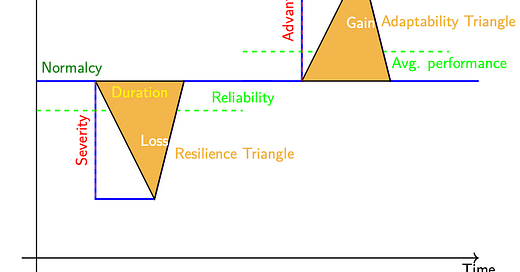When a network faces disruption, understanding its response is crucial. Resilience, reliability, and robustness describe how networks resist, recover from, and even benefit from shocks. Grounded in systems theory and enriched by research across several fields, resilience theory now plays a critical role in everything from cybersecurity to urban planning.
At its core, resilience describes a network’s ability to adapt and recover when things go wrong. Reliability measures the probability that a network performs as intended under various conditions, and robustness reflects the capacity to maintain performance in the face of perturbations. Beyond merely returning to a previous state, a resilient system can actually improve in response to challenges—a concept sometimes referred to as anti-fragility.

Central to these discussions is the Resilience Triangle. This framework quantifies resilience by measuring the extent and duration of performance loss following a disruption. By calculating the area within the triangle, planners can assess total performance loss and evaluate strategies such as:
Redundancy: Designing multiple pathways for critical routes to keep the system operating even when parts fail.
Over-Provisioning: Building in extra capacity to handle peak demands or emergency conditions.
Simulations show that networks with high connectivity and few choke points tend to be more resilient. However, enhancing resilience can involve trade-offs, often challenging short-term efficiency in favor of long-term recovery and improvement.
We can extend this to an Adaptability Triangle to captures the system's ability to exploit a temporary gain.
Designing networks to manage disruptions goes beyond simply restoring performance; it involves rethinking how recovery can lead to improvement. The Resilience Triangle provides a measure of performance loss and recovery, while the Adaptability Triangle shows the reaction to a temporary performance gain. By aiming for systems that are not merely robust but also adaptive, we can build networks that not only weather shocks but also exploit opportunities.

Key Terms in Resilience
A precise understanding of resilience requires clear definitions. Here are the essential terms:
Baseline and Operational States
Normalcy: The baseline state where the network operates without disruptions.
Resilience: The network's ability to adapt and recover from disruptions.
Reliability: The probability that the network meets its intended function under a range of conditions.
Robustness: The system's capacity to maintain performance despite disturbances.
Redundancy: The presence of alternative routes or modes that lessen overall loss when one part fails.
Impact of Disruption
Breakdown: The phase during which a significant disruption reduces network performance.
Severity (Advantage): The measure of functionality lost—or gained—due to negative—or positive—disruptions.
Fragility: The frequency of failures, indicated by the time between disruptions.
Duration: The length of time that network performance remains below (or above) its intended level.
Recovery and Adaptation
Annealing: The gradual process through which a network restores performance after a disruption, via re-routing, temporary repairs, or modifications.
Recoverability: The ability of the system to bounce back from performance losses.
Resourcefulness: The effective use of available resources during a disruption to maintain or enhance functionality.
FIN
Keep reading with a 7-day free trial
Subscribe to Transportist to keep reading this post and get 7 days of free access to the full post archives.



